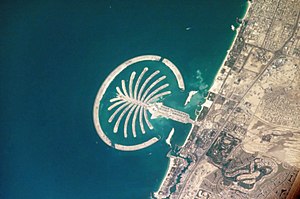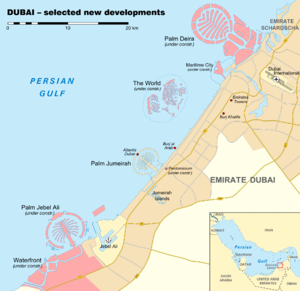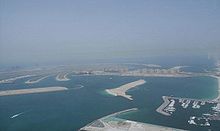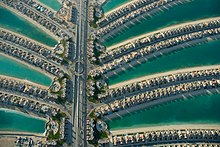Palm Jumeirah
This article needs to be updated. (July 2013) |



The Palm Jumeirah is an artificial archipelago in United Arab Emirates, created using land reclamation by Nakheel, a company owned by the Dubai government, and designed and developed by Helman Hurley Charvat Peacock/Architects, Inc. It is one of three planned islands called the Palm Islands (Palm Jumeirah, Palm Jebel Ali and Palm Deira) which would have extended into the Persian Gulf, increasing Dubai's shoreline by a total of 520 kilometres (320 mi). The Palm Jumeirah is the smallest and the original of three Palm Islands originally under development by Nakheel. It is located on the Jumeirah coastal area of the emirate of Dubai, in the United Arab Emirates (UAE).
Transportation

Palm Jumeirah Monorail is a 5.4-kilometre-long (3.4 mi) monorail connecting the Atlantis Hotel to the Gateway Towers at the foot of the island, opened on 6 May 2009.[1] located on Palm Jumeirah island in Dubai, United Arab Emirates. The monorail connects the Palm Jumeirah to the mainland, with a planned further extension to the Red Line of the Dubai Metro.[2] The line opened on 30 April 2009.[3] It is the first monorail in the Middle East.[4]
Construction
Construction began with the Palm Jumeirah island in June 2001 and the developers announced handover of the first residential units in 2006.[5]
In early October 2007, the Palm Jumeirah had already become the world's largest artificial island.[6] Also at this time, 75% of the properties were ready to hand over, with 500 families already residing on the island.[6] By the end of 2009, 28 hotels were opened on the Crescent.[6]
Hotels and resorts
The Palm Jumeirah has a number of hotels, resorts, and hotel residences:[7]
- The Fairmont Palm Hotel & Resort
- Kempinski Hotel & Residences,
- Rixos The Palm Dubai
- Atlantis, The Palm
- Sofitel the Palm Dubai
- Royal Club, Dubai
- Oceana, The Palm Jumeirah
- Jumeirah Zabeel Saray
- Oceana Residence, Palm Jumeirah
- Tiara Residence
- One & Only The Palm
- Palm Jumeirah Residences
- Beach Apartments, Palm Jumeirah
- The Residences, Palm Jumeirah
- Waldorf Astoria, Palm Jumeriah[8]
- Kingdom Of Sheba, Palm Jumeirah
- Th8 Hotel Resort & Residence, Palm Jumeirah
- Anantara Hotel Dubai The Palm Resort & Spa
- Royal Bay, Palm Jumeriah[9]
Controversy
The complexities of the construction were blamed, in part, for the extended delays to the completion of the project, the date of which was pushed back multiple times and was nearly two years late. Further controversy was engendered when it was revealed that after launching the project, Nakheel increased the number of residential units on the island (with a concomitant reduction in the amount of physical space between individual properties) from the originally announced 4,500 (comprising 2,000 villas purchased early in the expectation of greater separation between properties.[10] This increase was attributed to Nakheel miscalculating the actual cost of construction and requiring the raising of additional capital, although Nakheel has never commented publicly on the matter.[citation needed]
The outer break water was designed as a continuous barrier, but by preventing natural tidal movement, the seawater within the Palm was becoming stagnant. The problem was corrected by adding another gap in the barrier.[11] As explained in the National Geographic Channel's documentary Impossible Islands, part of its MegaStructures series, the breakwater was subsequently modified to create gaps on either side, allowing tidal movement to oxygenate the water within and prevent it stagnating, albeit less efficiently than would be the case if the breakwater did not exist.[11][12] This same episode addressed the issue of marine life as well, but stated that the breakwater has actually encouraged marine life and that new marine species are moving into the area.
In a 2009 article describing the collapsing Dubai economy, The New York Times reported that the Palm was sinking and this has been confirmed now by geological surveys, at the moment it is 5 millimetres (0.20 in) per year but this could increase rapidly. Furthermore, there are many reported cases where people had bought houses before they were built and are furious about the space available now and the way they seem to be living on top of each other.[13] Nakheel refuted the claims by the New York Times who had quoted one small ground survey firm that the island was sinking. They defended the single claim by saying that there had been no reports of any structural problems on any of the buildings on the island which would be expected if there were any subsidence. Nakheel also outlined that claims suggesting Palm Jumeirah has sunk by 5 mm, as detected by remote sensing (satellite) techniques, are not possible given that NASA's laser altimeter satellites have an accuracy of only ± 50 millimetres (2.0 in).[14]
Gallery
-
Atlantis The Palm on 21 October 2009, The Lost Chambers aquarium
-
Atlantis The Palm on 20 Nov 2009, Sea view from the Palm crescent, in front of Atlantis
-
Villas on a frond -
Palm Jumeirah's Fronds -
Palm Jumeirah aerial view on 1 May 2007 -
Palm Jumeirah aerial view on 1 May 2007 -
Palm Jumeirah aerial view on 5 January 2013 -
Palm Jumeirah Residences villas
See also
- Palm Islands
- The World
- The Universe
- Tourism in Dubai
- Palm Grandeur
- Jumeirah Islands
- The Taj Exotica Hotel & Resort
- Longshore drift
References
- ^ Nice and Easy, but Fares Not So Fair
- ^ "Middle East's first monorail to start services in Palm Jumeirah by April". Gulf News. 7 August 2008. Retrieved 11 August 2008.
- ^ "Palm monorail tried and tested – The Knowledge News". TimeOutDubai.com. Retrieved 27 August 2010.
- ^ "ME's 1st monorail to begin services in April". MENAFN.com. 8 August 2008. Retrieved 11 August 2008.
- ^ "The Palm Jumeirah". Nakheel. 2006. Retrieved 11 February 2007.
{{cite web}}: External link in|publisher= - ^ a b c "Dubai's Palm and World Islands – progress update". AMEInfo. 4 October 2007. Retrieved 28 October 2007.
- ^ "Hotels in Palm Jumeirah, Dubai. Book your hotel now!". Booking.com. Retrieved 15 January 2016.
- ^ "Waldorf Astoria Palm Jumeirah set for January opening in Dubai". GulfNews.com. 27 December 2013. Retrieved 15 January 2016.
- ^ "Royal Bay at The Palm Jumeirah".
- ^ ""Palm before a storm?" Daily Telegraph article by Catherine Moye, 20th August 2005". The Daily Telegraph. London. 20 August 2005. Retrieved 21 May 2010.
- ^ a b "Palm Island Dubai FAQ".
- ^ "MegaStructures – National Geographic Channel episode guide".
- ^ Laid-Off Foreigners Flee as Dubai Spirals Down, New York Times, 11 February 2009
- ^ "Nakheel: Palm Jumeirah is 'not sinking' - Real Estate". ArabianBusiness.com. Retrieved 15 January 2016.








